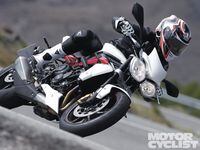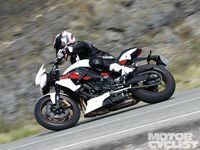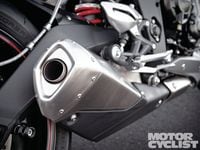They say: “Taking the Street Triple to another level.”
We say: “The level best.”
For such an aggressive looking motorcycle, it’s remarkable how obedient and agreeable Triumph’s Street Triple is. Unlike its big brother, the Speed Triple, which can be overwhelming in all the best ways, the lighter, more agile Street Triple is more civilized in any urban setting—and, thanks to that lovely 675cc triple, it’s still ridiculously rewarding to ride fast once the road opens up. It’s hardly surprising to learn that the Street Triple has been Triumph’s best-selling model for five years running, with more than 50,000 sold. It’s the perfect blend of performance, style, and value, and it easily satisfies novices and experts alike.
This year’s comprehensive redesign, the first since its 2007 debut, began with a decision to relocate the exhaust under the engine from under the seat. This move lets stylists slim the tailsection dramatically, but the changes are more than skin deep. The reconfigured subframe required an all-new main frame, which allowed engineers to tweak the geometry to make an already fine-handling machine behave even better as well as address a few customer complaints.
The new subframe is narrower than before, but because it’s made from two high-pressure diecast halves instead of the previous many-piece design, there’s twice as much storage space under the seat—enough to carry a full-sized U-lock. The main frame is composed of fewer pieces—eight, not 11—to save weight, and the steering lock has been increased from 28 to 31 degrees to improve U-turns and other extreme low-speed handling, which was another complaint about the old bike.
The new frame and asymmetric swingarm save 3 pounds. The more compact exhaust saves almost 8 lbs., while a lighter rear wheel and rear brake save 2 more. Combined, this cuts a claimed 13 lbs. from behind the bike’s midsection, changing the critical front/rear weight distribution percentage from 49/51 to 52/48. This, plus half a degree less rake, 2.6mm more trail, and a slightly lower (4mm) setting for the adjustable swingarm pivot all make the latest Street Triple more responsive and, at the same time, more stable than before.
The press launch was held in Almeria, Spain, where we took advantage of the area’s racetrack-grade backroads—and lax law enforcement—to get acquainted with this updated machine. We rode the R model, which, in addition to red styling accents, also adds fully adjustable Kayaba suspension and radial brake calipers for a $600 premium over the non-adjustable, $9399 base model. The R-bike’s handling is superlative, especially at low to medium speeds. The upright handlebar requires only the lightest input to initiate a turn, and perfectly balanced, firm-but-never-harsh suspension action helps it hold any line at any pace. Corner exits are especially impressive. Excellent rear-end stability, a capable shock and low weight help the bike hold surprisingly tight exit lines, even hard on the gas.
Very strong Nissin brakes, fit from the factory with toothy pads and braided-stainless lines, provide plenty of power and crisp lever feel. In fact, the only cornering complaint was a slight tendency to understeer during trail braking, but this was so slight we’re betting it can be tuned out with a fork adjustment. Otherwise, the handling is impeccable right up to triple-digit speeds, at which point you start wishing for lower clip-on handlebars. When “it gets a bit blowy,” as our Brit ride leader memorably said, buffeting sometimes causes you to feed unwanted steering inputs into the wide, high handlebars.
But the naked Street Triple isn’t intended for sustained, 120-mph blasts—especially since the optional flyscreen blocks slightly less wind than before now that the headlamps have been relocated lower and further back for a “tighter” look. The windblast is strong but also smooth and consistent, while the ergonomics are spot-on, creating a perfectly neutral, upright riding position that accommodates a wide range of riders.
Thankfully, Triumph barely altered the Street Triple’s sweetheart 675cc triple, maintaining its singular combination of low-end grunt and wailing, high-rpm acceleration. Claimed power output remains unchanged at 106 horsepower, but a revised intake system makes it sound even nastier now, especially in combination with the accessory (but still street-legal) Arrow titanium exhaust. A new throttle linkage is progressive, not linear like the old, to improve performance at small throttle openings—something previously accomplished through ignition retard. This change, and the related EFI recalibration, results in a claimed 30-percent increase in urban fuel economy. First gear is taller too, sacrificing some lazy hooliganism for smoother around-town acceleration, addressing another complaint of the old bike.
With sharper styling, even better handling, and less weight, Triumph has markedly improved what was already a winning bike. It also stands up to close inspection; Build quality, finish, and attention to detail—check the Triumph-embossed bar clamp, the brushed-aluminum bar ends, that meticulously riveted muffler cap—all look very premium for this price point. For anyone complaining that motorcycles are too niche-oriented, this is the answer—a nearly perfect, do-anything bike. Call it a very stylish UBM, then—a post-modern “universal British motorbike.”
Tech Spec















/cloudfront-us-east-1.images.arcpublishing.com/octane/VZZXJQ6U3FESFPZCBVXKFSUG4A.jpg)
/cloudfront-us-east-1.images.arcpublishing.com/octane/QCZEPHQAMRHZPLHTDJBIJVWL3M.jpg)
/cloudfront-us-east-1.images.arcpublishing.com/octane/HXOUJXQWA5HBHGRO3EMJIGFMVI.jpg)

/cloudfront-us-east-1.images.arcpublishing.com/octane/3TIWWRV4JBBOLDVGRYECVVTA7Y.jpg)
/cloudfront-us-east-1.images.arcpublishing.com/octane/KIX5O23D5NAIBGFXBN3327DKZU.jpg)
/cloudfront-us-east-1.images.arcpublishing.com/octane/7GJYDUIPXRGMTMQKN6ONYOLBOU.jpg)
/cloudfront-us-east-1.images.arcpublishing.com/octane/MUQLOVLL2ZDGFH25ILABNBXKTI.jpg)
/cloudfront-us-east-1.images.arcpublishing.com/octane/TNOU5DNE2BC57MFPMGN2EIDXAM.jpg)
/cloudfront-us-east-1.images.arcpublishing.com/octane/GTCXACQGJ5HAPDTGWUQKDEH44E.jpg)
/cloudfront-us-east-1.images.arcpublishing.com/octane/S35YGSEMEZB4BLTDJTSZPF4GLA.jpg)
/cloudfront-us-east-1.images.arcpublishing.com/octane/5UOT6HPX2JFMRJAX6EH45AR4MQ.jpg)
/cloudfront-us-east-1.images.arcpublishing.com/octane/OKWOJWAKP5EP3OACCRRWPCIX2Q.jpg)
/cloudfront-us-east-1.images.arcpublishing.com/octane/2WF3SCE3NFBQXLDNJM7KMXA45E.jpg)
/cloudfront-us-east-1.images.arcpublishing.com/octane/G4MG6OUCJNBSHIS2MVVOTPX65E.jpg)
/cloudfront-us-east-1.images.arcpublishing.com/octane/IIGGWFOTOJGB7DB6DGBXCCMTDY.jpg)
/cloudfront-us-east-1.images.arcpublishing.com/octane/QSTCM6AVEZA5JJBUXNIQ3DSOF4.jpg)
/cloudfront-us-east-1.images.arcpublishing.com/octane/U4I7G625B5DMLF2DVIJDFZVV6M.jpg)
/cloudfront-us-east-1.images.arcpublishing.com/octane/B6XD6LS6IVCQPIU6HXDJSM3FHY.jpg)
/cloudfront-us-east-1.images.arcpublishing.com/octane/ICL63FEDDRDTTMINYICCEYGMDA.jpg)
/cloudfront-us-east-1.images.arcpublishing.com/octane/FCGZHQXRBZFLBAPC5SDIQLVF4I.jpg)
/cloudfront-us-east-1.images.arcpublishing.com/octane/WNOB6LDOIFFHJKPSVIWDYUGOPM.jpg)

/cloudfront-us-east-1.images.arcpublishing.com/octane/X33NU3E525ECRHXLNUJN2FTRKI.jpg)